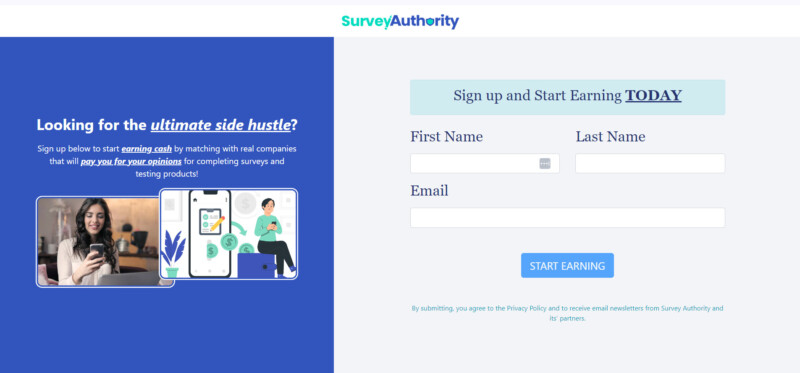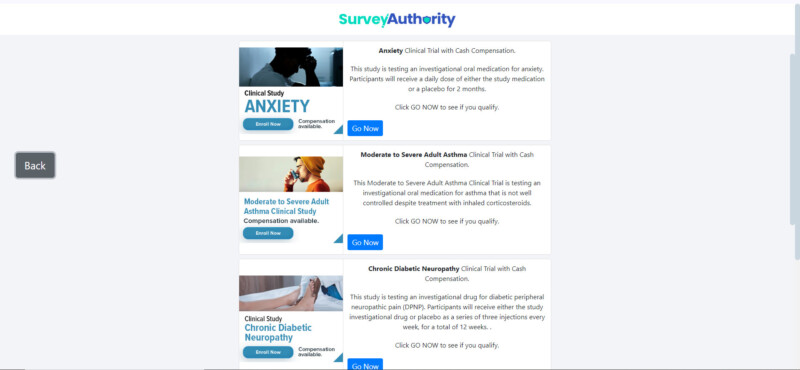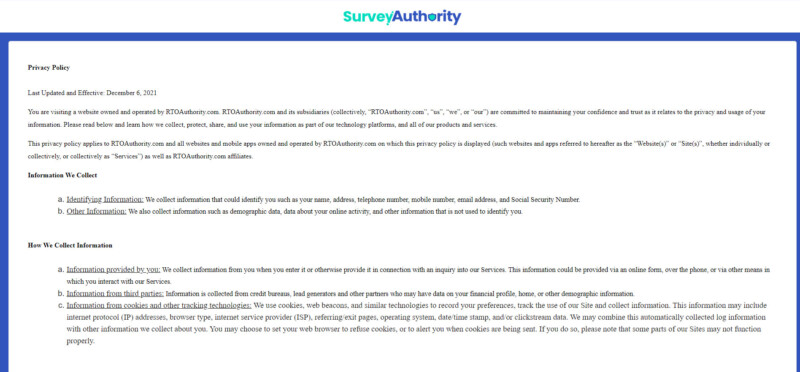When making money online, taking surveys can seem easy and convenient. Survey Authority claims to help you find these paid survey opportunities. But is it worth your time and effort? After personally trying out countless survey sites and examining Survey Authority, there are some key points to note.

Survey Authority is designed to connect users with various survey panels, but its value remains questionable. The platform charges $37 plus potential upsells, yet user reviews suggest finding legitimate surveys through this service can be hit or miss. As someone who has explored numerous survey sites, I can say that while paid surveys aren’t inherently scams, this platform might not be the best option for everyone.
Before investing money or time in a survey site, it is vital to ensure that it meets high data quality and compliance standards. Properly assessing the technology and security in place is essential to safeguarding your personal information. In my experience, there are free and highly reputable alternatives worth exploring.

Survey Authority Foundations are rooted in standards and practices that guarantee the reliability and integrity of survey data. They’ll touch upon specific scientific practices and the oversight roles within the bureau dedicated to these reviews.
USGS Fundamental Science Practices (FSP) form the backbone of survey authority, ensuring high-quality data and processes. These practices include rigorous methods for data collection, analysis, and publication.
FSP covers systematic planning and documentation, ensuring every step follows detailed guidelines. These standards prevent errors and biases, making the data trustworthy.
The release requirements demand peer reviews before data or publications are released. This step ensures other experts have validated the findings, maintaining scientific integrity.
FSP also emphasizes transparency. All methodologies and data sources must be publicly accessible, allowing external audits and verifications.
The bureau’s role in survey reviews is crucial. It acts as an oversight body to ensure compliance with established standards and regularly evaluates surveys for accuracy and reliability.
The bureau mandates strict adherence to quality control procedures. They review methodologies, ensuring they meet industry standards.
Bureau reviewers often work closely with surveyors during planning stages, advising on best practices. Their involvement reduces the risk of errors and increases the credibility of the survey results.
The bureau also addresses any disputes or issues raised during the review process. This independent oversight fosters trust among survey data users.
See Related: iSurveyWorld Review: Is It Worth Your Time and Effort?

When dealing with survey data, following a process to ensure its accuracy and usefulness is important. This involves peer reviews, approvals, and proper release of the results.
Peer review is when other experts check the survey’s data and methods. Survey Authority often uses this to ensure the information is solid. These reviews occur at different levels, such as within a science center or by an external group. Reviews look at how data was collected, the survey’s purpose, and if the findings match the standards set by the USGS.
This step helps to catch any mistakes and improve the survey. Peers ask questions, suggest changes, and sometimes point out what needs to be done differently. This feedback is essential to maintaining high-quality survey results.
Before survey data can be used or published, it needs several approvals. Survey Authority and organizations like the Office of Science Quality and Integrity have specific rules. For example, the USGS Survey Manual (SM 205.18) outlines procedures to ensure surveys meet all necessary guidelines and policies.
This process typically requires signatures from several department heads or committees. Approvals look at whether the survey follows all the laws and policies. This step acts as a safety net to prevent any issues.
Finally, the survey data is released. This involves sharing the approved findings with the public or specific groups. Survey Authority ensures the data is published in an understandable and accessible way, such as on its website or other platforms.
Releasing data includes final cross-checks to ensure everything is correct. Summaries or key points are sometimes highlighted to make important information stand out. This helps everyone understand the results, from researchers to the general public.
By following these steps, surveys are both credible and reliable.

Understanding quality and compliance standards is key to assessing survey authority reviews. These standards ensure that surveys meet high expectations, data integrity is maintained, and reviews are fair and thorough.
Quality consistency is essential. It starts with management creating a solid audit plan or program. Supervisory comments, meetings with team members, and work paper reviews keep everything on track. Effective audits, like those by the USGS, ensure that scientific data meets the set standards.
Regular supervisory reviews identify any deviations, ensuring adherence to compliance standards. This practice improves the quality and boosts confidence in the survey results.
Reviewing data and metadata ensures the accuracy and reliability of survey findings. Metadata, data about data, needs thorough checks to confirm that it correctly represents the data.
Metadata reviews are critical in scientific assessments where data integrity is paramount. Consistent metadata practice ensures the data’s context and accuracy, crucial for maintaining compliance review standards. Metadata is often scrutinized during external audits to ensure it aligns with set criteria.
Editorial standards are equally important in the review process. These standards help ensure that all reports and documents are clear, accurate, and error-free. Peer reviews play a vital role here, providing an additional layer of scrutiny.
Each document undergoes several stages: initial writing, peer review, and final editorial review. This multilayered process helps catch mistakes that could otherwise undermine the quality and credibility of the survey results. Following these editorial standards ensures all information presented is reliable and easy to understand.
See Related: Global Survey Hub Review: Unveiling User Experiences and Platform Credibility

When it comes to Survey Authority Review, understanding how legislation and policy adherence impact processes is crucial. You must consider guidelines set by federal bodies and specific policies within survey manuals.
The Office of Management and Budget (OMB) plays a significant role in setting assessment standards, especially highly influential ones. These Highly Influential Scientific Assessments (HISAs) are subject to stringent regulations to meet quality and reliability standards. For example, the OMB mandates that these assessments address potential errors and are transparent in methodology.
To ensure compliance, the USGS and other agencies must follow guidelines to confirm that their influential scientific information (ISI) and policy-sensitive data are accurate. This transparency is vital because these assessments often support highly visible public policies that can have wide-reaching effects.
Moreover, procedures for HISAs include rigorous peer review and clear documentation of uncertainties and assumptions. This helps maintain public trust and ensures scientific assessments inform policies without bias. So, you’re not just looking at a set of rules; you’re looking at a framework designed to support high-quality, influential science.
Within a survey authority, the Survey Manual, such as SM 502.3, contains detailed policies for conducting surveys. This manual ensures that all practices align with federal and local laws, promoting consistency and reliability.
Policies detailed in these manuals cover everything from data collection methods to reporting results. For instance, you might find specific procedures for managing policy-sensitive information to avoid undue influence or error. The policies also often include guidelines for training personnel so everyone involved is aware of the standards they must meet.
Furthermore, adhering to the Survey Manual isn’t just about following rules—it’s about ensuring that surveys produce accurate, reliable data that policymakers and stakeholders can trust. This adherence reinforces the credibility of the survey results, which is crucial when these results underpin highly visible projects or legislation changes.
By consistently following the Survey Manual, you help guarantee that survey results comply with OMB regulations and are reliable for influencing critical decisions. So, these manuals are integral to maintaining high standards in scientific and public policy-related surveys.

Assessing technology and security involves evaluating software tools and technologies and the presence of robust security measures. These assessments are crucial for maintaining system integrity and ensuring the safety of sensitive data.
Evaluating software and technology ensures your tools are up to the task. You need to look at how mature a technology is and whether it’s been proven effective. This is often done through a Technology Readiness Assessment (TRA). These assessments use metrics and are usually conducted by experts to ensure that hardware and software meet specific criteria.
Think about it like this: When introducing software to manage data, it’s essential to check its compatibility with your existing systems and reliability. Are there any known issues? Has the software undergone rigorous testing? Ask these questions to avoid headaches down the line. For instance, USGS often employs detailed, systematic evaluations to confirm a software tool’s suitability for complex data operations.
Security checks are your frontline defense against breaches and cyber-attacks. They’re not just about having a password; they involve a comprehensive review of systems, including browser security and data encryption methods. Different methods exist to conduct these assessments, such as testing the system, examining procedures, and interviewing staff.
This could mean performing a detailed review of your current IT and cybersecurity setup. You need to look at network security, access controls, and your system’s up-to-date privacy measures. The aim is to find vulnerabilities before they can be exploited. For example, if you work under a survey authority, failing to secure sensitive data can lead to breaches that compromise valuable information.
These checks should be regular. Regular evaluations help ensure that your security measures evolve alongside new threats, keeping your data safe and your peace of mind intact.
See Related: Surveysavvy Review: An In-Depth Look at Earning Potential and User Experience

Surveys are key when assessing land for industry use. They confirm land boundaries and ensure compliance with standards. Protecting against scams in these processes is crucial.
Understanding survey sites is crucial in assessing land for industry. Land surveys provide accurate boundaries and identify potential issues. Surveys verify that land meets the required standards for industrial use. They help to ensure compliance with regulations and avoid costly mistakes later.
Surveys are used to determine land’s suitability for specific purposes. For instance, understanding ALTA Land Surveys is essential, as lenders and title companies require them for property transactions. They offer detailed and accurate info about land title requirements, making them vital for any industry planning to build facilities or expand operations.
Maintaining compliance with industry standards protects against future problems. This involves ensuring that all surveys and assessments meet the required standards. The Department of Defense and various other organizations have specific tools and methods approved for data collection, like online surveys and electronic focus group tools.
Survey programs ensure that everything from land use efficiency to boundary disputes is handled accurately. This step-by-step verification process helps industrial planners set up reliable operations. Tools provided by programs, such as those from the Navy Survey Program Office, ensure that collected data is precise and supports efficient industry planning.
Protecting against scams is a vital aspect of land assessment. With many online platforms offering paid surveys, it is essential to choose reputable sources for land surveys. Scams can lead to inaccurate data, legal issues, and financial loss. To mitigate risks, utilize tools and services approved by reputable organizations.
Joining a trustworthy community, such as those offering paid surveys like Surveoo.com, ensures reliable data collection. Always look for verified reviews and feedback before engaging in any service. Taking these precautions ensures that land assessments are accurate and safe, paving the way for successful industry use.
Last updated: July 30, 2025